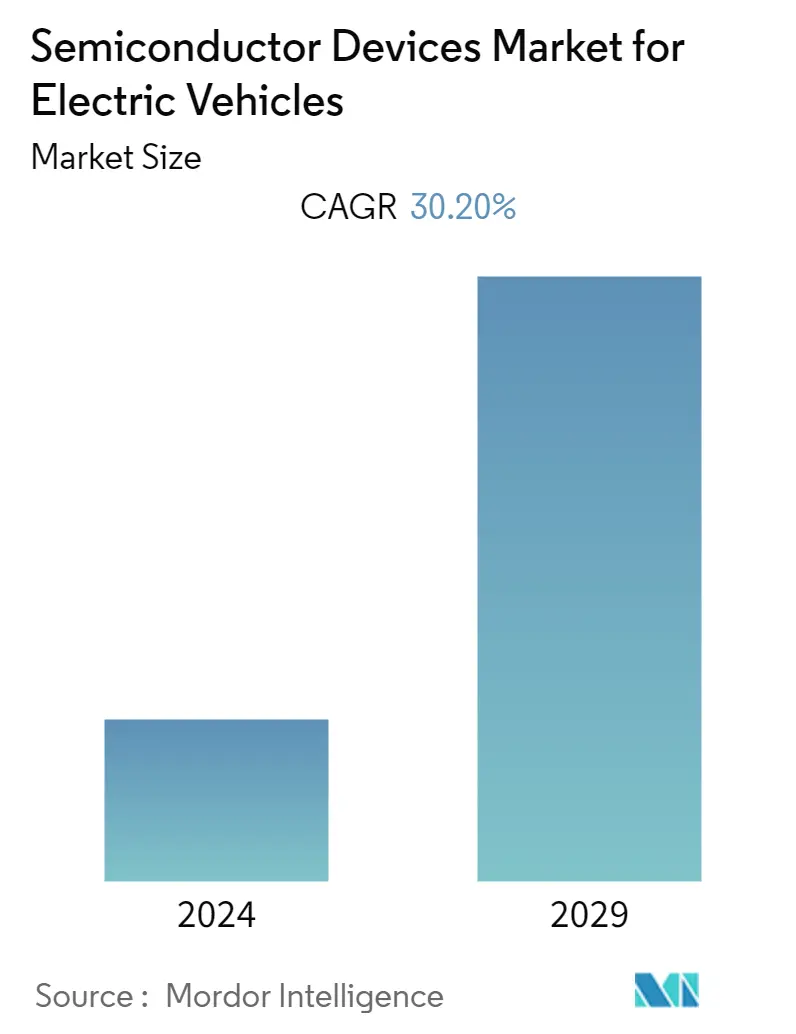Market Size of Semiconductor Devices Industry for Electric Vehicles

| Study Period | 2019 - 2029 |
| Base Year For Estimation | 2023 |
| CAGR | 30.20 % |
| Fastest Growing Market | Asia-Pacific |
| Largest Market | Asia-Pacific |
| Market Concentration | Low |
Major Players*Disclaimer: Major Players sorted in no particular order |
Need a report that reflects how COVID-19 has impacted this market and its growth?
Electric Vehicles Semiconductor Devices Market Analysis
The semiconductor devices market for electric vehicles is expected to grow at a CAGR of 30.2% over the forecast period. The growing initiatives by the government for the adoption of electric vehicles and the rising demand for the longer driving range and faster charging time in EVs drive the need for electric vehicles' semiconductor devices.
- The automobile manufacturing industry has been hit hard by semiconductor chip shortages globally. Leading carmakers reported a reduction in production by as much as about 40% due to these shortages. Owing to this, various initiatives were taken by regions to boost chip production. For instance, in August 2022, the United States passed the CHIPS act (Creating Helpful Incentives to Produce Semiconductors). The division received funding of USD 52.7 billion, which is expected to be used for the research, development, and production of semiconductors.
- Furthermore, in September 2022, Vedanta Ltd and Taiwan's Foxconn signed an MoU with the Gujarat government for a USD 1.54 trillion investment for setting up a semiconductor and display FAB manufacturing unit. Vedanta Displays Ltd. will set up the display FAB unit at an investment of INR 94,500 crore (USD 945,000 million) .
- The changing government requirements regarding the reduction of CO2 emissions, coupled with the electrification of passenger vehicles by various major automakers, are contributing to the growth of demand for SiC-based semiconductors in the market. Moreover, SiC is used for applications in EV batteries. As a result of its use in batteries, it extends the driving range per charge, reduces the time it takes to charge the battery, and increases battery efficiency by requiring less battery capacity and weight.
- The market is witnessing significant investments from various carmakers to produce Electric Vehicles. For instance, in April 2022, Honda Motor Co. Ltd. announced its plans to invest USD 63 billion in electric vehicle development over the next decade. The auto manufacturer plans to budget approximately JPY 8 trillion (USD 61 Billion) for its research and development expenses, with approximately JPY 5 trillion (USD 38 billion) focused on electrification and software.
- The COVID-19 pandemic influenced the overall semiconductor manufacturing market from the demand and supply sides. Additionally, the global lockdowns and closure of semiconductor plants further fueled the supply shortage. However, many of these effects are to be short-term effects. Precautions and safeguards by governments globally to support automotive and semiconductor sectors could help revive industry growth.
- According to the Korea Automotive Technology Institute or Katech, the global shortage of automotive semiconductors that started around 2020 will continue to affect the global car industry over a couple of years. Even after 2023, some companies may still be affected. Until September 2021, major global automakers such as Volkswagen, GM Motors, Stellantis, and Honda witnessed their accumulated production volume fall by around 30% from the same period in 2019, according to Katech. However, Hyundai Motor and Kia, Korea's two leading automotive firms under Hyundai Motor Group, produced only 14% fewer vehicles during the first three quarters of 2021 compared to 2019.
